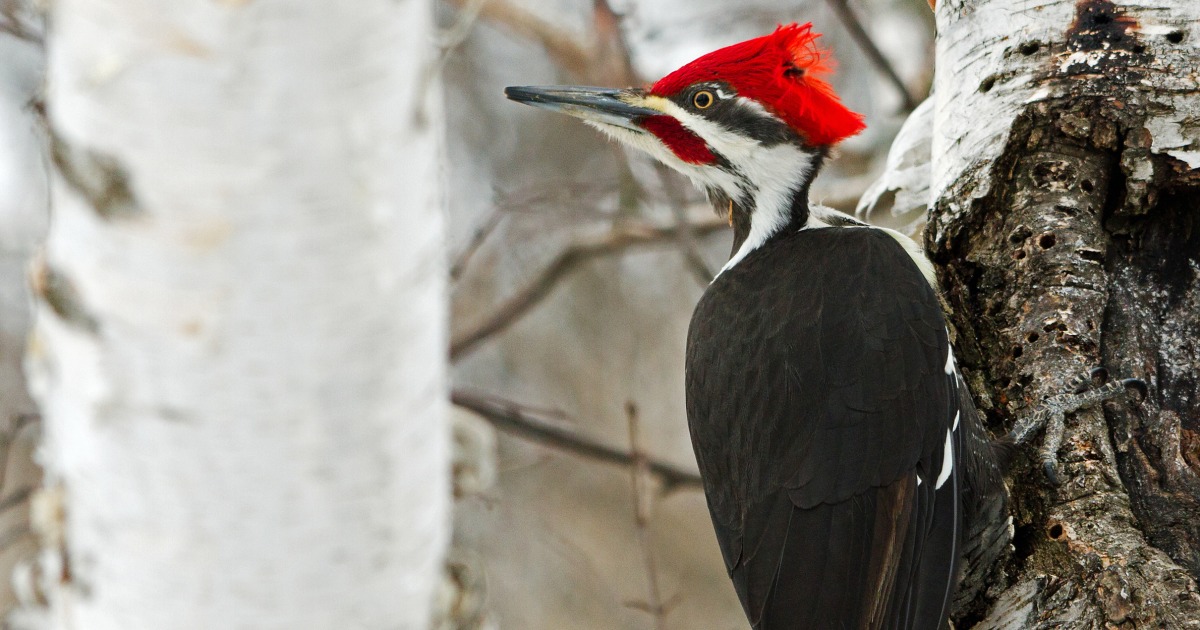
The incessant drumming of a woodpecker on a hollow tree can be an annoying distraction for anyone who has to listen to it. To other woodpeckers, however, it’s as distinct and as telling as any bird song.
A new study, published last week in the journal PLOS Biology, found that both a woodpecker’s drumming and a songbird’s singing are governed by similar specialized structures in the birds’ brains, structures that are not found in other nonsinging birds. And both behaviors serve the same purposes of marking out territory and attracting mates, the researchers said.
The findings are especially intriguing because the singing of songbirds has important parallels to human speech, and so the drumming of woodpeckers could now, too, give new scientific insights into how humans talk.
“Woodpeckers use drumming as songbirds use song,” said evolutionary biologist Matthew Fuxjager, an associate professor of ecology, evolution and organismal biology at Brown University in Providence, Rhode Island, and senior author of the new research. “The structures are similar in size and shape, and are similar in terms of where we find them in the brain.”
The research combines two approaches to the study of woodpeckers: work by Fuxjager into their ecology, and work by his collaborator, Erich Jarvis, a professor of neurogenetics at Rockefeller University in New York, into the genetic mechanisms at play.
The researchers found that drumming by woodpeckers and singing by songbirds are governed by very similar structures in the forebrains of the animals, made of cells that strongly express the protein parvalbumin.
“When you study songbirds, hummingbirds and parrots, you find areas that control vocal learning express parvalbumin more than other parts of the brain,” Fuxjager said.
He noted that structures of cells that strongly express parvalbumin are also seen in human brains, but they aren’t seen in birds that don’t communicate with vocalizations.
It was a surprise, therefore, when the research led by Fuxjager and Jarvis found such structures in the woodpecker brains but not in birds that don’t sing, such as emus, penguins and ducks (quacks don’t count).
Fuxjager suggested in the study that both the singing and the drumming originated in specialized brain structures for refined motor control in the ancestors of modern birds.
Although they might sound quite different, both behaviors are remarkably similar. Both involve complex muscle coordination, and both are used to mark out territory to competitors, which can hear the drumming or singing from afar.
Both drumming and singing are also used as courtship signals when a male hopes to attract a mate. Future studies will look for other similarities, such as if the patterns of woodpecker drumming are learned at an early age, like the singing of songbirds, he said.
Fuxjager noted that there are more than 200 species of woodpecker around the world and that they inhabit every continent, except Australia.
Each species of woodpecker drums in short bursts with a specific rhythm and at a specific speed, depending on what they want to communicate and to whom.
If a woodpecker doesn’t get its drumming pattern right, that will be noticed by other woodpeckers of that species, which use it to assess whether an individual is a worthy competitor. If they get it wrong, however, then other woodpeckers won’t be able to recognize it or understand it.
Drumming also has certain advantages over singing, since it has other uses: It’s used to reveal edible insects in wood and to make cavities in tree trunks for nesting.
But the drumming to find insects or make nests is much slower than the repetitive — and loud — drumming that woodpeckers use to mark out territory and attract mates, Fuxjager said.
Scientists study the singing of songbirds — and possibly now the drumming of woodpeckers — because it has parallels to human speech.
Both are learned when young, for example, but have a genetic component. Both require complex muscle coordination and both are controlled by specialized regions of the brain.
Jon Sakata, an associate professor of biology at McGill University in Montréal who specializes in the neurophysiological and behavioral mechanisms of songbird communications, noted the similarities between the forebrain structures that seem to control drumming in woodpeckers, described in the new study, and singing in songbirds. Sakata wasn’t involved in the latest study.
In both cases, structures of brain cells — neurons — that contain parvalbumin seem to be important for performing complex motor movements and for learning to produce such movements, Sakata said in an email.
“Because parvalbumin neurons are also implicated in speech production and learning, this is a wonderful example of how similar brain mechanisms can be co-opted for different behaviors across species,” he said.
Source: | This article originally belongs to Nbcnews.com










